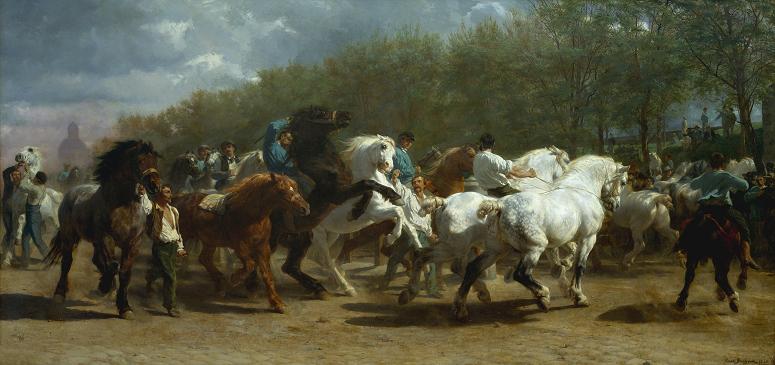Rosa Bonheur (1822 - 1899). Rosa Bonheur, born Marie-Rosalie Bonheur, was a French artist, an animalière and sculptor, known for her artistic realism. Her best-known paintings are Ploughing in the Nivernais, first exhibited at the Paris Salon of 1848, and now at the Musée d'Orsay in Paris, and The Horse Fair, which was exhibited at the Salon of 1853 and is now in the Metropolitan Museum of Art, in New York City. Bonheur was widely considered to be the most famous female painter during the nineteenth century. Bonheur was born on 16 March 1822 in Bordeaux, Gironde, the oldest child in a family of artists. Her mother was Sophie Bonheur, a piano teacher; she died when Rosa Bonheur was eleven. Her father was Oscar-Raymond Bonheur, a landscape and portrait painter who encouraged his daughter's artistic talents. Though of Jewish origin, the Bonheur family adhered to Saint-Simonianism, a Christian-socialist sect that promoted the education of women alongside men. Bonheur's siblings included the animal painters Auguste Bonheur and Juliette Bonheur and the animal sculptor Isidore Jules Bonheur. Francis Galton used the Bonheurs as an example of Hereditary Genius in his 1869 essay of the same title. Bonheur moved to Paris in 1828 at the age of six with her mother and siblings, her father having gone ahead of them to establish a residence and income. By family accounts, she had been an unruly child and had a difficult time learning to read, though even before she could talk she would sketch for hours at a time with pencil and paper. Her mother taught her to read and write by asking her to choose and draw a different animal for each letter of the alphabet. The artist credits her love of drawing animals to these reading lessons with her mother. At school she was often disruptive, and she was expelled from numerous schools. After a failed apprenticeship with a seamstress at the age of twelve, her father undertook to train her as a painter. Her father allowed her to pursue her interest in painting animals by bringing live animals to the family's studio for studying. Following the traditional art school curriculum of the period, Bonheur began her training by copying images from drawing books and by sketching plaster models. As her training progressed, she made studies of domesticated animals, including horses, sheep, cows, goats, rabbits and other animals in the pastures on the perimeter of Paris, the open fields of Villiers near Levallois-Perret, and the still-wild Bois de Boulogne. At fourteen, she began to copy paintings at the Louvre. Among her favorite painters were Nicholas Poussin and Peter Paul Rubens, but she also copied the paintings of Paulus Potter, Frans Pourbus the Younger, Louis Léopold Robert, Salvatore Rosa and Karel Dujardin. She studied animal anatomy and osteology in the abattoirs of Paris and by dissecting animals at the École nationale vétérinaire d'Alfort, the National Veterinary Institute in Paris. There she prepared detailed studies that she later used as references for her paintings and sculptures. During this period, she befriended father-and-son comparative anatomists and zoologists, Étienne Geoffroy Saint-Hilaire and Isidore Geoffroy Saint-Hilaire. A French government commission led to Bonheur's first great success, Ploughing in the Nivernais, exhibited in 1849 and now in the Musée d'Orsay in Paris. Her most famous work, the monumental The Horse Fair, measured eight feet high by sixteen feet wide, and was completed in 1855. It depicts the horse market held in Paris, on the tree-lined boulevard de l'Hôpital, near the Pitié-Salpêtrière Hospital, which is visible in the painting's background. There is a reduced version in the National Gallery in London. This work led to international fame and recognition; that same year she traveled to Scotland and met Queen Victoria en route, who admired Bonheur's work. In Scotland, she completed sketches for later works including Highland Shepherd, completed in 1859, and A Scottish Raid, completed in 1860. These pieces depicted a way of life in the Scottish highlands that had disappeared a century earlier, and they had enormous appeal to Victorian sensibilities. Bonheur exhibited her work at the Palace of Fine Arts and The Woman's Building at the 1893 World's Columbian Exposition in Chicago, Illinois. Though she was more popular in England than in her native France, she was decorated with the French Legion of Honour by the Empress Eugénie in 1865, and was promoted to Officer of the order in 1894. She was the first female artist to be given this award. The art dealer Ernest Gambart represented her; he brought Bonheur to the United Kingdom in 1855, and he purchased the reproduction rights to her work.
more...













